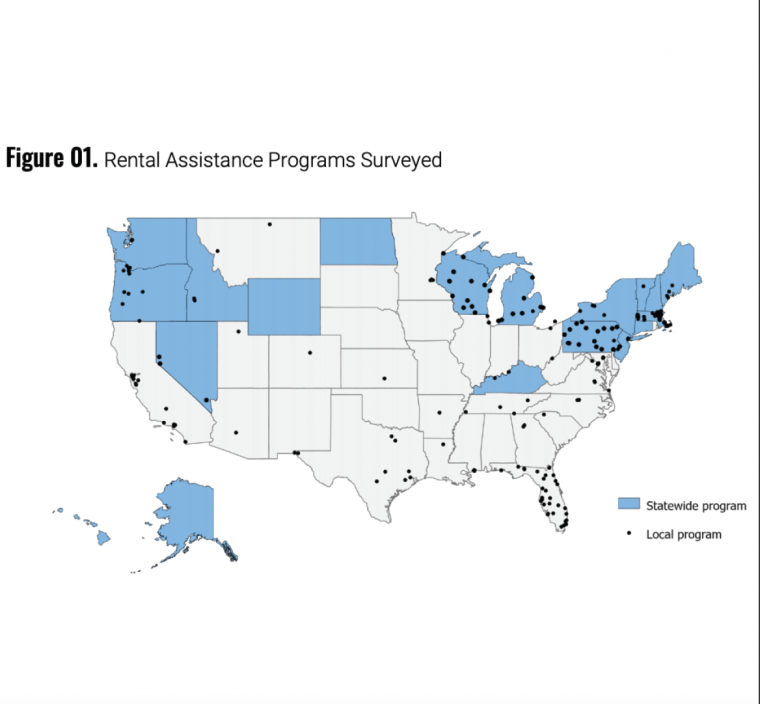
COVID-19 Emergency Rental Assistance: Analysis of a National Survey of Programs

To better understand how government agencies and their partner organizations responded to the explosion of rental needs during the COVID-19 pandemic, the NYU Furman Center, the Housing Initiative at Penn, and the National Low Income Housing Coalition collaborated on a research brief, “COVID-19 Emergency Rental Assistance: Analysis of National Survey of Programs.” This research presents the results of an in-depth survey completed between August and October of 2020. The survey looked at 220 COVID-19 rental assistance programs across the country, most of which relied on CARES Act Funding. A second round of surveys in December 2020 provided updated figures on 70 of the programs.
Overview of Program Characteristics
The 220 programs spanned 40 states, including Washington, D.C., 22 of which administered statewide rental assistance programs and 198 of which were locally administered programs. Of these programs, 72 percent were created in response to the pandemic, while the rest were expanded or modified versions of existing programs. As funding sources impact program requirements, the surveys also tracked whether each used funding from the Coronavirus Relief Fund (CRF) or Community Development Block Grant (CDBG-CV), two separate sources of federal funding appropriated under the CARES Act.
Most programs had three or more goals, highlighting the complexity of rental assistance needs, but the two most common goals were to stem evictions and prevent homelessness. To accomplish these goals, more than half of the jurisdictions partnered with nongovernmental entities to review applications, select recipients, and more. The most common eligibility criteria for programs included income-based limits on applicants and requiring households to have experienced some form of COVID-19-related financial hardship.
Less than half of programs created priority groups and 98 percent of programs required that tenants apply, rather than landlords applying on behalf of their tenants or properties. Although it was overwhelmingly tenants who were required to apply, over 90 percent of the programs chose to provide the subsidy directly to landlords upon approval. Relatedly, the study found that almost all programs placed at least one restriction on landlords who agreed to receive rental assistance funding.
Finally, programs differed in the level of documentation required by applicants to verify eligibility. Documentation of income and a current lease were the most requested documents, while programs were more split on personal identification, with 60 percent requiring a driver’s license or some form of state ID.
Key Challenges
The survey found that program administrators faced multiple challenges designing and implementing the programs, particularly those related to application completion and staff capacity. The report also notes difficulties programs faced with landlord cooperation, which was cited by almost half the programs as an issue.
Set of Program Outcome Measures to Determine Success
The analysis cannot identify the downstream impact of these programs on household outcomes. Nevertheless, it provides outcome measures across the programs to explore how they performed with respect to the number of applicants, the number of households assisted, and funding spent.
- Volume of Applications: The researchers found that demand met or exceeded supply for most programs, and that the volume of applications increased over time.
- Households Assisted: While the average program served more households than expected, the data was skewed by some outliers; the median value suggests that a slight majority of programs actually served fewer households than expected.
- Funds Obligated: Studying 58 of the programs, the research found that the median program had already obligated 97 percent of funds between August-October 2020.
Lessons Learned
The brief concludes by looking at the relationship between program characteristics and outcomes. The researchers found several key themes that may inform future programs or iterations of existing programs. For example, the source of funding affected performance -- there was a clear relationship between the restrictiveness of funding and the ability to distribute rental assistance within a limited time period. This meant that programs that used local or philanthropic dollars were able to reach more households than expected, while the effectiveness of other programs may have been hampered by HUD’s CARES Act funding criteria.
The brief also examines implementer type, experience, and capacity, and it ends by considering the potential effects of requirements on landlords or eligibility criteria for tenants. It concludes with final points about the usefulness of both partnerships and flexibility.
As localities continue to start new rental programs or expand existing ones using new federal funding, the research and lessons learned from this brief will hopefully help them refine their models and reach more households in need.


